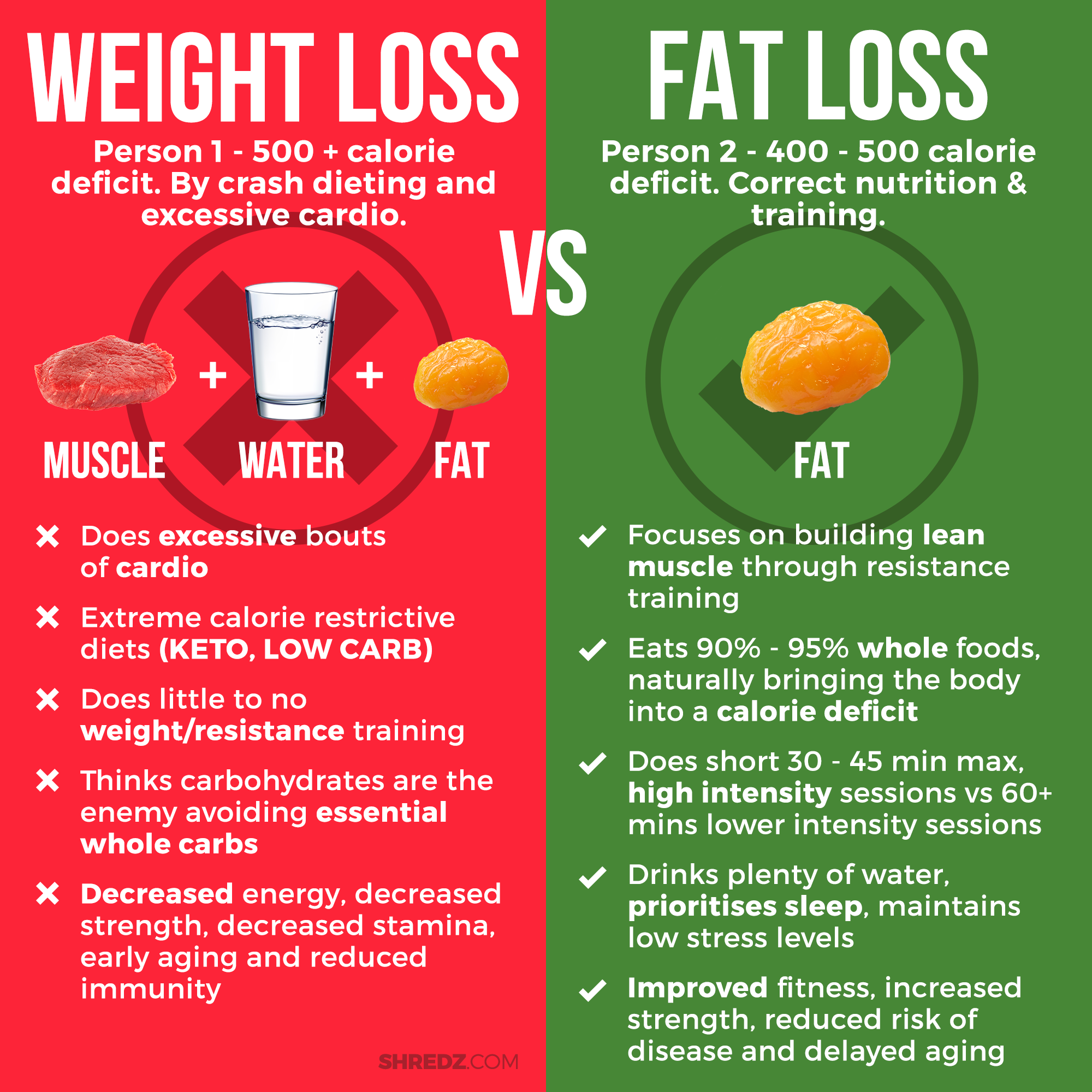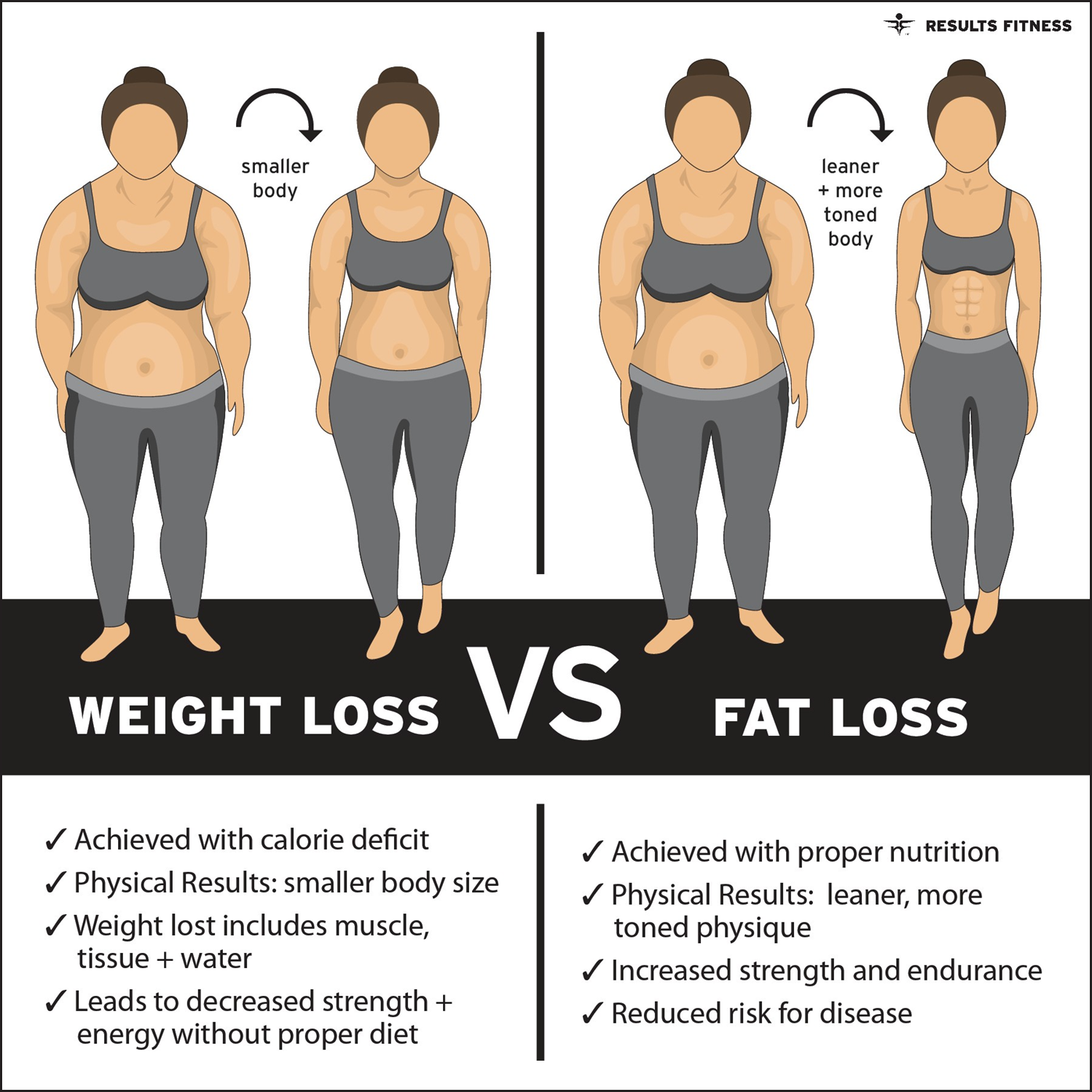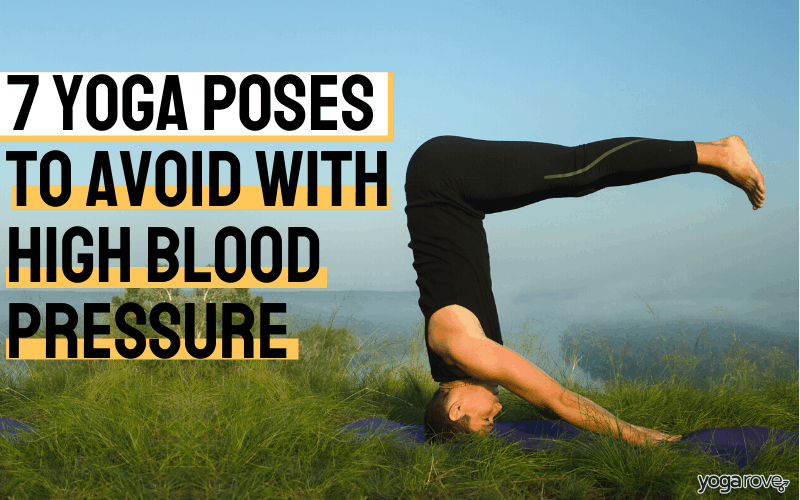How to lose fat instead of weight, focus on strength training and a balanced diet with adequate protein. Avoid crash diets and prioritize muscle retention.
Losing fat while maintaining muscle mass requires a strategic approach. Strength training helps build and preserve muscle, which boosts metabolism. A balanced diet rich in protein supports muscle repair and growth. Avoid drastic calorie cuts that lead to muscle loss.
Consistency in exercise and nutrition is key. Incorporate healthy fats, complex carbs, and stay hydrated. Regular physical activity, including cardio, aids in fat loss. Sleep and stress management also play crucial roles in fat loss. Aim for sustainable, healthy habits rather than quick fixes. This approach ensures long-term success and overall well-being.
Credit: www.facebook.com
Introduction To Fat Loss Vs. Weight Loss
Losing fat and losing weight might sound the same, but they are not. It’s important to understand the difference to reach your fitness goals effectively. This section will delve into the core differences between fat loss and weight loss, and why focusing on fat is more beneficial for your health.
The Misconceptions
Many people think losing weight is all about the numbers on the scale. This is one of the biggest misconceptions. The scale does not differentiate between muscle, fat, and water. Losing muscle mass can make you lighter but less healthy.
Another common myth is that cutting calories drastically will help you lose fat. Extreme diets often lead to muscle loss and can slow down your metabolism. This makes it harder to keep the weight off in the long run.
It is also widely believed that doing endless hours of cardio will burn fat. While cardio is good for your heart, strength training is more effective for fat loss. Building muscle helps to boost your metabolism, which helps in burning more calories even at rest.
Setting Realistic Goals
Setting realistic goals is crucial for sustainable fat loss. Aim for losing 1-2 pounds of fat per week. This is a healthy and achievable target.
- Start by measuring your body fat percentage, not just your weight.
- Focus on losing inches rather than pounds.
- Take progress photos to visually track your changes.
Make a balanced plan that includes a mix of diet, strength training, and cardio. Eating a balanced diet with enough protein will help you retain muscle mass. Strength training will help you build muscle and boost your metabolism. Cardio will help improve your heart health and burn calories.
Remember, losing fat is a gradual process. Patience and consistency are key.
Understanding Body Composition
Understanding body composition is key to losing fat instead of weight. It’s not just about what you see on the scale. Your body is made up of different types of tissues. This includes fat mass and lean mass. Knowing the difference can help you make better health choices.
Fat Mass Vs. Lean Mass
Your body has two main components: fat mass and lean mass. Fat mass includes all the fat in your body. Lean mass includes muscles, bones, water, and organs. Both are important for your health, but they serve different roles.
| Fat Mass | Lean Mass |
|---|---|
| Stores energy | Supports bodily functions |
| Insulates the body | Includes muscles and bones |
| Too much can be harmful | Higher lean mass is generally healthier |
Importance Of Muscle Preservation
Muscle preservation is crucial when losing fat. Losing muscle can slow your metabolism. This makes it harder to lose fat in the future. Focus on keeping your lean mass while reducing fat mass.
- Strength training helps maintain and build muscle.
- Proper nutrition is essential. Eat enough protein to support muscle growth.
- Stay hydrated. Water is vital for muscle function.
Avoid diets that cause quick weight loss. They often lead to muscle loss. Aim for a balanced approach. This means eating a variety of foods and getting regular exercise.
Use a mix of cardio and strength training exercises. This helps you lose fat while keeping muscle. Remember, the goal is to improve your body composition, not just lower the number on the scale.
Role Of Nutrition In Fat Loss
Understanding the role of nutrition is key to losing fat effectively. Eating the right foods helps your body burn fat instead of muscle. Proper nutrition ensures you feel energized and stay healthy.
Macronutrient Balance
Macronutrients are proteins, fats, and carbohydrates. Balancing these is crucial for fat loss. Proteins help build and repair muscles. They also keep you full longer. Good sources include chicken, fish, and beans.
Fats are essential for your body’s functions. Choose healthy fats like avocados, nuts, and olive oil. Avoid trans fats found in junk food.
Carbohydrates provide energy. Opt for whole grains, fruits, and vegetables. Avoid refined carbs like white bread and sugar.
| Macronutrient | Sources |
|---|---|
| Proteins | Chicken, Fish, Beans |
| Fats | Avocados, Nuts, Olive Oil |
| Carbohydrates | Whole Grains, Fruits, Vegetables |
Caloric Deficit Without Deprivation
To lose fat, consume fewer calories than you burn. This is called a caloric deficit. But don’t deprive yourself of essential nutrients.
Follow these steps to achieve a caloric deficit safely:
- Calculate your daily calorie needs.
- Reduce your calorie intake by 500 calories per day.
- Focus on nutrient-dense foods like vegetables and lean proteins.
Avoid crash diets that can harm your body. Eat balanced meals that keep you satisfied and energized. Drink plenty of water to stay hydrated.
Keep track of what you eat using a food diary or app. This helps you stay on target with your caloric deficit.
Impact Of Protein Intake
Understanding the impact of protein intake is essential for losing fat, not just weight. Protein plays a crucial role in muscle preservation, which helps maintain a healthy metabolism. This section dives into the importance of protein and the best sources to include in your diet.
Protein’s Role In Preserving Muscle
Protein helps keep your muscles strong. When you lose weight, you want to lose fat, not muscle. Muscle burns more calories than fat, even when you rest. This means having more muscle can help you burn more calories each day.
Eating enough protein can help you keep your muscles. It can also help you feel full longer. This can make it easier to stick to your diet. Aim to include protein in every meal to support muscle health.
Best Sources Of Lean Protein
Choosing the right protein sources is key. Lean protein options are low in fat but high in nutrients. Here are some of the best sources of lean protein:
- Chicken breast – High in protein, low in fat.
- Turkey – A lean alternative to red meat.
- Fish – Rich in protein and omega-3 fatty acids.
- Egg whites – Pure protein with no fat.
- Greek yogurt – High protein, low fat, and good for digestion.
- Tofu – A plant-based protein that’s low in fat.
- Lentils – Great for vegetarians and full of fiber.
Incorporate these lean protein sources into your daily meals. A balanced diet with sufficient protein can help you lose fat while preserving muscle mass.
Strategic Exercise For Fat Loss
Strategic exercise is key to losing fat instead of weight. The right exercises can help you burn fat effectively. This guide breaks down the essentials of strength training and high-intensity interval training (HIIT).
Strength Training Essentials
Strength training builds muscle. Muscle burns more calories than fat, even at rest.
- Focus on compound exercises: These exercises work multiple muscle groups at once. Examples include squats, deadlifts, and bench presses.
- Use free weights: Free weights engage more muscles than machines. They also improve balance and coordination.
- Progressive overload: Gradually increase the weight you lift. This keeps your muscles challenged and growing.
- Rest between sets: Give yourself 1-2 minutes of rest between sets. This helps you lift heavier and longer.
- Consistency is key: Aim to strength train at least three times a week.
Incorporating High-intensity Interval Training
HIIT involves short bursts of intense exercise followed by rest. It’s efficient and effective for fat loss.
- Warm-up: Start with 5 minutes of light cardio. This prepares your body for exercise.
- Choose your exercises: Pick 4-5 exercises like sprints, burpees, and jumping jacks.
- Intensity: Perform each exercise at maximum effort for 30 seconds.
- Rest: Rest for 30 seconds between exercises.
- Repeat: Complete 3-4 rounds of your chosen exercises.
- Cool down: Finish with 5 minutes of stretching.
| Exercise | Duration | Rest |
|---|---|---|
| Sprints | 30 seconds | 30 seconds |
| Burpees | 30 seconds | 30 seconds |
| Jumping Jacks | 30 seconds | 30 seconds |
| Mountain Climbers | 30 seconds | 30 seconds |
Combining strength training and HIIT can maximize fat loss. These strategies keep your body engaged and burning fat efficiently.

Credit: shredz.com
The Importance Of Sleep And Recovery
Proper sleep and recovery are crucial for How to Lose Fat Instead of Weight. Many people focus on diet and exercise. They often forget the role of sleep and recovery. Sleep helps our body repair and burn fat efficiently. Recovery ensures our muscles grow and remain healthy.
Sleep’s Effect On Metabolism
Sleep directly affects our metabolism. Poor sleep can slow down metabolism. This makes it harder to lose fat. During sleep, our body regulates hormones. Leptin and ghrelin are two key hormones. Leptin controls hunger and ghrelin stimulates appetite. Lack of sleep increases ghrelin and decreases leptin. This makes us feel hungrier and crave unhealthy foods.
Good sleep also boosts insulin sensitivity. This helps our body use glucose properly. Less sleep can lead to insulin resistance. This increases fat storage, especially in the belly.
Rest For Muscle Repair
Recovery is vital for muscle repair. After a workout, muscles need time to heal. Rest helps muscles grow stronger and bigger. This is important for fat loss. More muscle mass means a higher metabolism. This helps burn more calories at rest.
Regular rest also prevents injuries. Overworking muscles can lead to strains and injuries. Injuries can halt progress and set back fat loss goals.
Here are some tips for effective recovery:
- Get 7-9 hours of sleep each night.
- Include rest days in your workout routine.
- Stay hydrated and eat balanced meals.
- Consider light stretching or yoga on rest days.
Remember, sleep and recovery are just as important as diet and exercise. They play a crucial role in losing fat and maintaining a healthy body.
Consistency Over Perfection
Losing fat is a journey that requires consistency over perfection. Small, steady efforts help more than big, inconsistent ones. This approach ensures sustainable results without stress.
Setting Achievable Targets
Set achievable targets that fit your lifestyle. Avoid extreme goals that feel overwhelming. Break down your main goal into smaller, manageable steps.
| Target | Time Frame |
|---|---|
| Lose 1 pound of fat | 1 week |
| Increase water intake | Daily |
| Walk 10,000 steps | Daily |
Adapting Lifestyle For Long-term Success
Adapting your lifestyle is crucial for long-term success. Choose activities that you enjoy. This makes it easier to stick with them. Integrate healthy habits into your daily routine. How to Lose Fat Instead of Weight.
- Choose whole foods over processed foods
- Stay active with fun exercises
- Get enough sleep every night
Consistent efforts in these areas bring lasting results. Remember, it’s about progress, not perfection.
Monitoring Progress Beyond The Scale
Focusing on losing fat, not just weight, requires a different approach. A scale tells only one part of the story. Monitoring progress beyond the scale gives a fuller picture of your journey towards better health.
Using Body Measurements
Body measurements give a clear view of fat loss. Use a tape measure to track key areas. Measure your waist, hips, arms, and thighs. Record these numbers weekly. This shows you where you lose fat.
| Body Part | Measurement |
|---|---|
| Waist | __ inches |
| Hips | __ inches |
| Arms | __ inches |
| Thighs | __ inches |
Tracking Fitness Levels
Fitness levels show how your body improves. Track your strength and endurance. Record how many push-ups or sit-ups you can do. Note how long you can run or how far you can walk. Check your progress weekly. Use a fitness tracker or a simple notebook.
- Push-ups: __ reps
- Sit-ups: __ reps
- Running: __ minutes
- Walking: __ miles
Tracking your fitness helps see improvements beyond the scale. It shows how much stronger and fitter you get. This motivates you to keep going.
Navigating Plateaus And Setbacks
Everyone hits plateaus and setbacks during their How to Lose Fat Instead of Weight journey. It’s a normal part of the process. Understanding how to navigate these challenges is crucial. Let’s explore how to adjust your plan and stay motivated.
Adjusting The Plan
When progress stalls, it might be time to tweak your approach. Small changes can make a big difference.
- Change your workout routine: Try new exercises or increase intensity.
- Review your diet: Ensure you’re eating enough protein and cutting excess carbs.
- Track your progress: Use a journal to note what works and what doesn’t.
Consistency is key, but so is flexibility. Adjusting your plan can help break through plateaus.
Staying Motivated
Setbacks can be discouraging. Keeping your motivation high is essential for success.
- Set small goals: Break your main goal into smaller, achievable steps.
- Celebrate victories: Reward yourself for reaching milestones, no matter how small.
- Stay positive: Focus on your progress, not just the setbacks.
Remember, every step forward counts. Keep your eyes on your goals and stay determined. How to Lose Fat Instead of Weight.
Conclusion: Embracing A Holistic Approach
How to Lose Fat Instead of Weight, a holistic approach is essential. This means balancing diet, exercise, and lifestyle. It’s not just about shedding pounds but about overall health. Let’s dive into the key areas.
Balancing Diet, Exercise, And Lifestyle
Balancing your diet, exercise, and lifestyle is crucial for losing fat. Focus on nutrient-dense foods. These include fruits, vegetables, lean proteins, and whole grains. Avoid processed foods and sugary drinks.
Exercise plays a vital role too. Engage in both cardio and strength training. Cardio helps burn calories. Strength training builds muscle, which boosts metabolism. Aim for at least 150 minutes of moderate exercise weekly.
Lifestyle choices impact How to Lose Fat Instead of Weight significantly. Get enough sleep every night. Aim for 7-9 hours. Manage stress through meditation, hobbies, or social activities. Stress can lead to weight gain by increasing cortisol levels.
Maintaining Results Long Term
Maintaining fat loss is about sustainable habits. Create a balanced meal plan you enjoy. This makes it easier to stick to. Track your progress with a journal or app. It helps you stay on track and adjust as needed.
Regular exercise should become a part of your routine. Find activities you love, like dancing, hiking, or sports. This ensures consistency. Set realistic goals and celebrate small victories. It keeps you motivated and focused.
Support is essential for long-term success. Surround yourself with positive influences. Join fitness groups or find a workout buddy. This provides accountability and encouragement.
| Key Area | Tips |
|---|---|
| Diet |
|
| Exercise |
|
| Lifestyle |
|
Adopting a holistic approach to fat loss ensures lasting results. It improves your overall well-being. Start today and embrace a healthier lifestyle.

Credit: kaynutrition.com
Frequently Asked Questions
How Can I Lose Fat Without Losing Weight?
Focus on strength training and maintain a balanced diet. Prioritize protein intake and healthy fats. Drink plenty of water. Consistency is key.
What Foods Help Burn Fat?
Consume lean proteins, healthy fats, and whole grains. Include plenty of vegetables and fruits. Avoid processed foods and sugary drinks.
Is Cardio Or Weightlifting Better For Fat Loss?
Weightlifting is better for fat loss. It helps build muscle, which increases metabolism. Cardio can support overall fitness.
Can I Lose Fat By Eating More Protein?
Yes, eating more protein can help. It boosts metabolism and supports muscle maintenance. It also keeps you full longer.
Conclusion
Achieving fat loss instead of just weight loss requires consistent effort and smart strategies. Focus on balanced nutrition, strength training, and adequate rest. Sustainable habits lead to long-term success. Remember, patience and persistence are key. Stay committed to your goals for a healthier, leaner you.




Leave a Reply